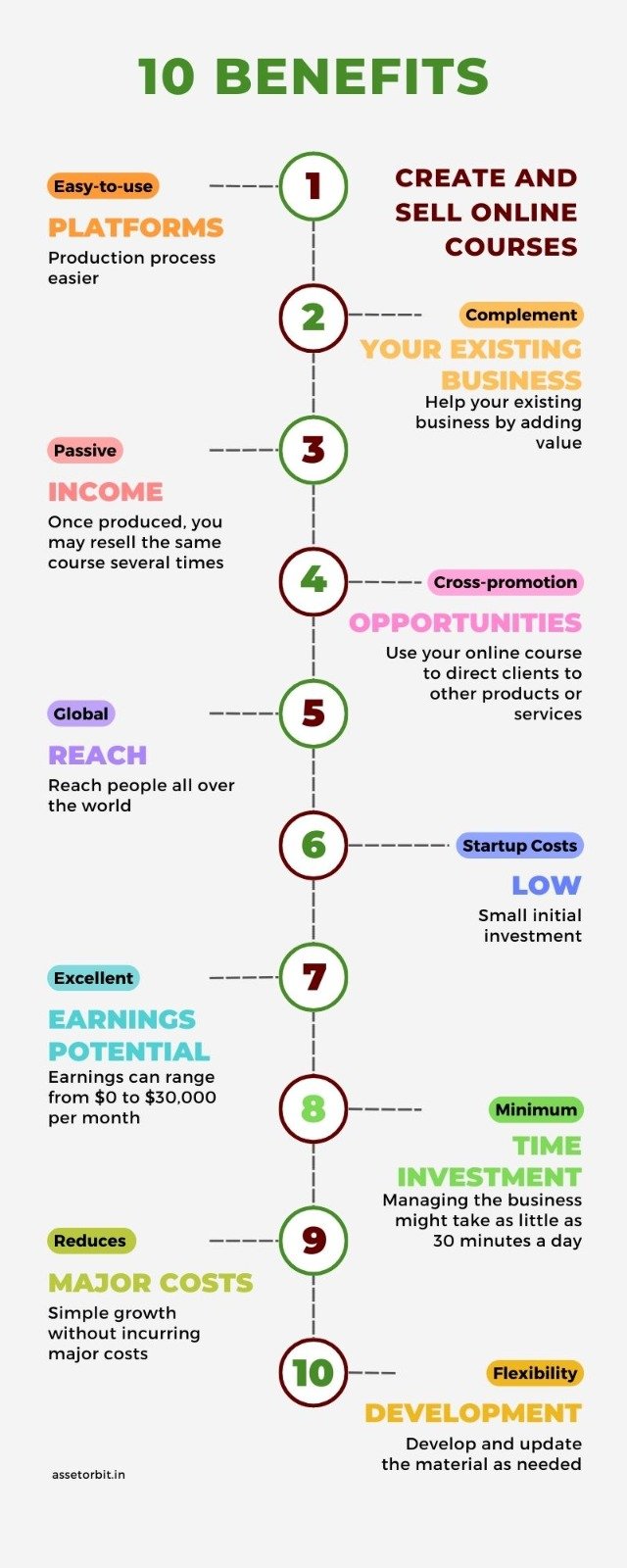Online courses provide flexibility, accessibility, and the opportunity to transform expertise into a profitable business. Creators can earn anywhere from $0 to over $30,000 per month. To design and sell your own online course, you must first decide on a subject, research your intended students, choose a platform, develop and test your course material, and finally, advertise it.
In Short
Sell Online Courses
Are you ready to enter the growing online education market?
It’s time to create and sell online courses!
Education is in high demand, providing significant value to students around the globe. Millions of people are turning to online courses to meet their educational goals, whether it’s learning a new skill, expanding their knowledge, or seeking personal growth.
Why should you jump at this opportunity? Here are some compelling reasons:
High Demand: Millions of individuals are purchasing online courses to improve their abilities, both within and outside of the traditional educational system.
Profitability: With access to free or low-cost information, developing online courses provides high profit margins.
Efficiency: Learners prefer organized, step-by-step courses over surfing infinite free web resources, which can result in confusion and wasted time.
Online Courses
Online courses are a modern alternative to traditional classroom education, offering a more flexible and convenient method of learning. Instead of attending lectures and seminars in person, you can study from the comfort of your own home or any other place of your choosing. All training materials are available online, allowing you to learn at your own speed and on your own timetable.
Here are some important details about online courses:
Flexibility: Learn when and where you choose. Online courses work around your personal and professional obligations.
Accessibility: You may see all course materials online, including videos, readings, and interactive exercises.
Self-Paced Learning: Work through the material at your own speed, revisiting topics as required.
Profitability of Online Courses
Online courses are not only advantageous to students, but they are also highly profitable for creators.
As a beginner, you can make anywhere from $0 to more than $30,000 each month. With skill and high-quality material, certain creators may earn more than $1 million every month.
How to Design and Sell Online Courses?
Creating and marketing online courses is a wonderful way to earn a passive income while sharing your knowledge with a worldwide audience. Online courses provide flexibility, accessibility, and the potential to convert your expertise into a successful business. Follow these steps to effectively create and sell your online course.

1. Decide What You Would Like to Teach
Selecting a topic is the first step in developing an online course. Here are several methods for deciding what to teach:
Leverage Existing Followings:
If you already have a company or personal following, such as a chef selling cookbooks, think about delivering an online course on advanced cooking methods, skills, and recipes.
Start from Scratch:
If you don’t already have an audience, you’ll need to develop one via smart marketing. Examine your business operations and determine if an online course could enhance them.
Draw from Experience:
Reflect on your professional or personal experiences and interests. Choose something you are passionate about; this will keep you motivated. Make a list of your interests, skills, and achievements to see where they connect and can provide the basis for your course subject.
Research Popular Courses:
Analyze the most popular online courses to gain inspiration and understand market needs.
2. Identify Your Customers and Validate Demand
Target Audience:
Determine who will get the most from your course. To discover a specific target market, narrow your niche as much as feasible.
Validate Demand:
Investigate your competitors to ensure there is a need for your course. Consider best-selling books on Amazon, online courses, YouTube gurus, and podcasts. If others are effectively offering courses on the same subject, it suggests a strong demand.
Engage Your Audience:
If you already have an audience, ask them directly what they want to know via surveys, social media postings, or email marketing.
3. Create a Course
Course Outline:
Begin with a distinct topic title and plan your course lesson by lesson.
Content Creation:
Choose whether to use text, audio, video, or a mix of these. Video is frequently the most engaging medium.
Platform Setup:
Select a platform to host your course. Thinkific, Kajabi, and Shopify are all viable options with proper applications. A members-only Facebook group can help build a community and provide additional assistance.
5 Online course platforms
| Try it | Benefits | Fee | |
| Teachable | Easy-to-use platform Customizable sales pages | Starts at $39/month (Basic plan) with a 5% transaction fee | |
| Thinkific | Comprehensive platform Selling courses with various customization options | Starts at $49/month (Basic plan) with no transaction fees | |
| Udemy | Popular marketplace with a large user base Ideal for reaching a wide audience | 50% revenue share for organic sales, and 3% for instructor-promoted sales | |
| Kajabi | Advanced automation features | Starts at $149/month (Basic plan) with no transaction fees | |
| Podia | Digital downloads with integrated email marketing | Starts at $39/month (Mover plan) with no transaction fees |
Testing:
Before launching a course, it is crucial to assess its content and usability from a student’s perspective.
4. Get the Word Out
Pricing Model:
Research competition prices and choose a plan that works for you. Create discounts and offers that encourage them to buy.
Promote Success:
Highlight customer success stories to build trust and demonstrate the value of your course to prospective students.
Marketing Strategies:
To reach your target audience, use social media campaigns, paid advertising, email marketing, and other methods.
5. Provide Support
FAQ Section:
Create a detailed FAQ section on your website to answer typical inquiries.
Community Engagement:
Encourage engagement in your Facebook group, where students can support each other.
Regular Q&A Sessions:
Organize frequent webinars to handle student inquiries.
Outsourced Support:
As your student base increases, consider delegating support responsibilities to mentors or freelancers to generate passive income while avoiding becoming overly committed.
How to Create a Course to Sell in India?
Creating and selling a course in India entails several important steps:
First, pick what you want to teach based on your interests, abilities, or current business initiatives. Investigate popular themes and analyze your target audience’s needs. Validate demand by researching rivals, best-selling publications, and interacting with prospective students via surveys or social media.
Next, construct a comprehensive course plan and compelling material in text, audio, or video format. Choose an appropriate platform to host your course, such as Thinkific, Kajabi, or a Shopify setup with suitable applications, and think about forming a supportive community through a members-only Facebook group.
Make sure to test your course thoroughly before publishing it. When you’re ready, promote your course effectively using paid social media ads, email marketing, and other channels; set reasonable prices and consider offering discounts.
Finally, include a frequently asked questions (FAQ) section, have regular Q&A sessions, and get involved in the community to help students succeed in the long run.
Benefits of Create and Sell Online Courses
Creating and selling online courses has various advantages, making it a promising business opportunity for many entrepreneurs and professionals. Here are several major advantages:

1. Easy-to-use Platforms
Modern platforms make the course production process easier, allowing you to focus on content rather than technical concerns.
2. Complement Your Existing Business
Online courses may help your existing business by adding value for your clients.
3. Passive Income
Once produced, you may resell the same course several times, creating a passive income source.
4. Cross-promotion Opportunities
Use your online course to direct clients to other products or services, and vice versa.
5. Global Reach
Because online availability allows you to reach people all over the world, you may greatly extend your market.
6. Low Startup Costs
The initial investment is small, frequently as little as $0, making it accessible to everyone.
7. Excellent Earnings Potential
Earnings can range from $0 to $30,000 per month, with certain creators making more than $1 million.
8. Minimum Time Investment
Once created, managing the business might take as little as 30 minutes a day.
9. Flexibility
You can develop and update the material as needed.
10. Scalability
The online course architecture enables simple growth without incurring major costs.
Final Thoughts
Creating and selling online courses is an attractive venture that allows you to share your knowledge, earn passive income, and reach a worldwide audience. With low initial expenses, significant earning potential, and the freedom to work on your own schedule, there’s never been a better moment to begin your adventure in the world of online education. Take advantage of this opportunity to transform your expertise into a profitable and effective course.
FAQ
What course is most in demand?
Many people want to take online courses right now on AI and machine learning, trading stocks, starting your own business, freelancing, and getting more done.
Anyone who wants to make more money or advance in their career will always be interested in any course that can help them do that quickly and well.
Check out sites like Udemy, Coursera, or Skillshare to see what's popular in your niche before you make your course.
Which course pays a lot?
Usually, courses that teach skills that lead to high wages bring in the most money. Courses in trading and investing, coding bootcamps, digital marketing, and business automation are a few examples.
People pay a lot for these courses because they know they can use what they learn right away to make or save money, which makes the investment worthwhile.
If your course helps people get better jobs, earn more money, or save time, it could earn you the most money.













Binance代码
Your article helped me a lot, is there any more related content? Thanks!